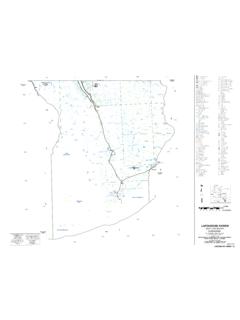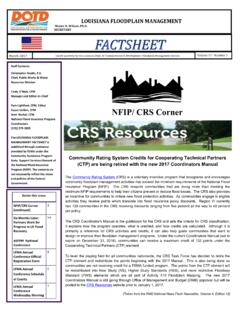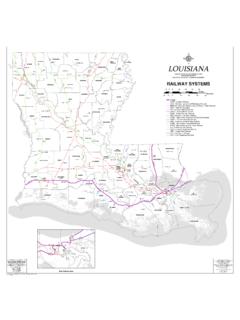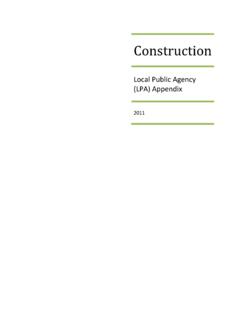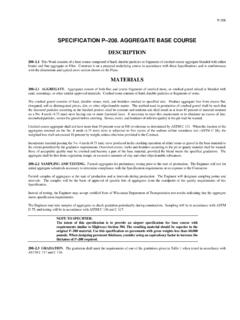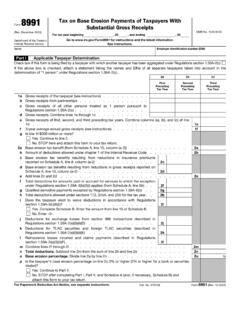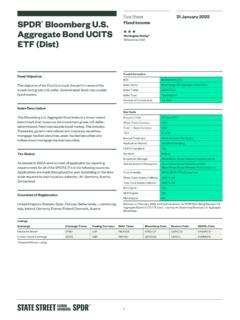Transcription of SIEVE ANALYSIS OF FINE AND COARSE AGGREGATE …
1 DOTD TR 113-11 Rev. 12/11 Page 1 of 19 Introduction Method of Test for SIEVE ANALYSIS OF FINE AND COARSE AGGREGATE DOTD Designation: TR 113-11 INTRODUCTION These methods of test are designed to determine the particle size distribution of fine and COARSE aggregates. The mix of COARSE and fine particles within the material being tested, in conjunction with the proposed use of the material, determines which test method is to be used. Table 1, Testing Requirements, identifies the basic appropriate test method. When materials are not listed in Table 1, the department will determine the test method to be used. When the percentage of material passing the 75 m (No. 200 SIEVE is critical to the proposed use, the district laboratory engineer has the authority to require a washed gradation in addition to or in place of dry sieving. These methods are not to be used alone for SIEVE ANALYSIS of aggregates recovered from asphaltic mixtures or for the SIEVE ANALYSIS of mineral fillers.)
2 The SIEVE ANALYSIS of mineral filler is to be determined in accordance with DOTD TR 102. The SIEVE ANALYSIS of aggregates recovered from asphaltic mixtures is determined in accordance with DOTD TR 309; only the steps for dry sieving in this procedure are used in conjunction with TR 309. TABLE OF METHODS Method A Dry SIEVE only. Method B Wash and dry SIEVE . Method C Split sample. Dry SIEVE , then wash representative portion of material passing the mm SIEVE . TABLE 1 Testing Requirements Material Method Concrete Sand or Mortar Sand TR 112 & TR 113 Method B Uncrushed COARSE AGGREGATE for Concrete TR 112 & TR 113 Method B Crushed COARSE AGGREGATE for Concrete TR 112 & TR 113 Method B Lightweight AGGREGATE for Concrete TR 113 Method A Recycled PCC base Course TR 112 & TR 113 Method B Sand Clay Gravel base Course AGGREGATE TR 112 & TR 113 Method C Sand base Course AGGREGATE TR 112 & TR 113 Method B Stone base Course AGGREGATE TR 112 & TR 113 Method C Recycled PCC base Course AGGREGATE TR 112 & TR 113 Method C ---continued--- DOTD TR 113-11 Rev.
3 12/11 Page 2 of 19 Introduction TABLE 1 Testing Requirements continued Crushed Slag base Course AGGREGATE TR 112 & TR 113 Method B Stone AGGREGATE Surface Course TR 112 & TR 113 Method C Sand Clay Gravel AGGREGATE Surface Course TR 112 & TR 113 Method C Recycled PCC AGGREGATE Surface Course TR 112 & TR 113 Method C RAP AGGREGATE Surface Course TR 113 Method A Crushed Slag AGGREGATE Surface Course TR 113 Method C Aggregates For Asphaltic Surface Treatment, Excluding Lightweight & Expanded Clay TR 112 & TR 113 Method B Gravel, Stone & Slag AGGREGATE for Asphaltic Mixtures TR 112 & TR 113 Method B COARSE Sand AGGREGATE for Asphaltic Mixtures TR 112 & TR 113 Method B Fine Sand AGGREGATE for Asphaltic Mixtures TR 112 & TR 113 Method B Natural Sand AGGREGATE for Asphaltic Mixtures TR 112 & TR 113 Method B Screenings AGGREGATE for Asphaltic Mixtures TR 112 & TR 113 Method B Lightweight and Expanded Clay AGGREGATE for Asphaltic Mixtures TR 113 Method A Pit Run Sand-Gravel AGGREGATE for Asphaltic Mixtures TR 112 & TR 113 Method B Recycled PCC AGGREGATE for Concrete Mix TR 112 & TR 113 Method B Crushed Gravel Stone or Crushed Slag for Asphalt Treated Drainage Blanket TR 112 & TR 113 Method B Granular Material Bedding Material TR 112 & TR 113 Method C Bedding Material.
4 Excluding Shell TR 113 Method A Sand for Embankment TR 112 & TR 113 Method B Blended Calcium Sulfate Non-Plastic Embankment TR 113 Method A Block Fill-Stone or Crushed Gravel TR 113 Method A Backfill TR 112 & TR 113 Method B DOTD TR 113-11 Rev. 12/11 Page 3 of 19 Introduction REFERENCE DOCUMENTS 1. AASHTO Designation; M 92, Standard Specifications for Sieves for Testing Purposes 2. DOTD TR 112, Amount of Material Finer than the 75 m SIEVE 3. DOTD TR 108, Splitting and Quartering Samples 4. DOTD TR 106, Determining Total Moisture and Free Moisture in Aggregates OVERLOADING A SIEVE is considered overloaded when the mass of the material retained on a SIEVE exceeds the maximum allowed as follows: 1. For sieves with openings m (No. 4) and larger, the mass in kilograms shall not exceed the product of x SIEVE opening in millimeters x effective area of sieving surface in square meters (the mass in pounds shall not exceed the product of x SIEVE opening in inches x effective area of sieving surface in square inches.)
5 2. For sieves with openings smaller than No. 4 ( m), the mass in kilograms shall not exceed 7 x effective area of sieving surface in square meters (the mass in pounds shall not exceed x area of sieving surface in square inches). Table 2 shows the maximum allowable mass retained on any SIEVE at the completion of the sieving operation for standard screen sizes based on the above relationships. Table 2 Maximum Mass of Material Retained on Selected Sieves/Screens SIEVE / Screen Sizes BOX SCREEN 420 x 340 mm (16 x 13 in) kg (lb) STD. MECHANICAL SHAKER SCREEN 375 x 580 mm (14 X 22 in) kg (lb) U. S. STANDARD 305 mm (12 in Dia.) kg (lb) U. S. STANDARD 254 mm (10 in Dia.) kg (lb) U. S. STANDARD 203 mm (8 in Dia.) kg (lb) 50mm (2 in) ( ) ( ) ( ) ( ) ( ) (1 in) ( ) ( ) ( ) ( ) ( ) (1 in) ( ) ( ) ( ) ( ) ( ) ( in) ( ) ( ) ( ) ( ) ( ) ( in) ( ) ( ) ( ) ( ) ( ) ( in) ( ) ( ) ( ) ( ) ( ) (No.)
6 4) ( ) ( ) ( ) ( ) ( ) < (No. 4 ) ( ) ( ) ( ) ( ) ( ) DOTD TR 113-11 Rev. 12/11 Page 4 of 19 Introduction DEFINITIONS For the purposes of this test procedure, the following definitions will apply. COARSE AGGREGATE Naturally occurring or manufactured materials that are retained on the mm (No. 4) SIEVE . Fine AGGREGATE Naturally occurring or manufactured materials that pass the mm (No. 4) SIEVE . Decantation Loss Decant Loss on Worksheet. The amount of material loss when washing over the 75 m SIEVE . Percent Difference The difference between the initial dry total mass and the accumulated total mass, expressed as a percentage of initial dry total mass. This difference is usually caused by material loss during testing or weighing errors. This parameter is used to judge the accuracy of the test result.
7 Split Sample A representative portion of material passing the mm (No. 4) SIEVE used to reduce sample size in order to determine the gradation of fine AGGREGATE . DOTD TR 113-11 Rev. 12/11 Page 5 of 19 Method A Method of Test for SIEVE ANALYSIS OF FINE AND COARSE AGGREGATE DOTD Designation: TR 113-11 Method A I. Scope This method of test is used to determine the particle size distribution of aggregates by dry sieving only. II. Apparatus A. Balance 1. Sample size 2 kg or less, readability and sensitivity to g. 2. Sample size greater than 2 kg, but not more than 5 kg, readability and sensitivity to 1 g. 3. Sample size greater than 5 kg, readability and sensitivity to 2 g. B. Mechanical SIEVE Shaker capable of imparting a vertical or lateral and vertical motion to the sieves, causing the particles thereon to bounce and turn, presenting different orientations to the sieving surface.
8 C. Sieves conforming to the requirements for AASHTO Designation M 92. SIEVE sizes will be appropriate for the specifications for which the material is being tested. Additional sieves may be necessary to prevent overloading of these primary sieves. D. Catch Pan E. Drying Device 1. Oven an oven capable of maintaining a temperature of 110 5 C (230 9 F), 55 5 C (131 9 F), and 38 5 C (100 9 F). 2. Hot Plate an approved hot plate with a shield. Open-flame hot plates must be equipped with a shield which evenly disperses heat and prevents direct contact of the flame with the drying pan. 3. Miscellaneous tools spoons, spatulas, brushes, etc. F. Personal Protective Equipment goggles, dust respirator, equipment for handling hot substances G. AGGREGATE Test Report DOTD Form No.
9 03-22-0745 (Figure A-1). III. Health Precautions Proper equipment and precautions are to be used whenever hot materials or equipment must be handled. Use container holders or gloves while handling hot containers. Use appropriate respirator and turn on ventilation system when working in dusty areas. IV. Sample Sample adequate material to comply with Table 1 after drying to constant mass; however, in no case shall the minimum sample size be less than 13 kg. V. Procedure A. Dry the sample in accordance with DOTD TR 106. B. Obtain a representative portion, in accordance with DOTD TR 108, which will yield at least the minimum quantity shown in Table 1. Record on the worksheet as initial dry total mass in the entry field. Note A-1: To obtain the minimum mass of the representative portion of lightweight DOTD TR 113-11 Rev.
10 12/11 Page 6 of 19 Method A AGGREGATE , multiply the values shown in Table 1 by TABLE 1 Approximate Minimum Mass of Dry Representative Portion 1 Maximum Size Approximate Minimum Mass, Dried 90 mm (3 in) 35 kg 75 mm (3 in) 30 kg 63 mm (2 in) 25 kg 50 mm (2 in) 20 kg mm (1 in) 13 kg mm (1 in) 10 kg mm ( in) 5 kg mm ( in) 2 kg mm ( in) 1 kg mm (No. 4) 500 g mm ( No. 8) 100 g 1 Maximum Size for the purpose of this test procedure, maximum size is defined as the first SIEVE on which the specifications allow material to be retained. C. Use the specifications to select the appropriate sieves to determine the particle distribution, including additional sieves necessary to prevent overloading of specification sieves. Note A-2: Refer to the introduction for information on overloading of sieves.


